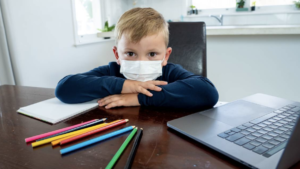Home » Commentary » Opinion » All quiet on the education leadership front
· Canberra Times
 Prime Minister Scott Morrison and other leaders rightly point to the risks facing the educational progress of young Australians as our nation locks down.
Prime Minister Scott Morrison and other leaders rightly point to the risks facing the educational progress of young Australians as our nation locks down.
Given the data showing that many students are already up to three years behind their international peers in reading, mathematics and science, our young learners cannot afford to miss a beat as they watch a very strange school year unfold.
As part of the national response to the COVID-19 emergency, all students and their teachers deserve long-term support from smart digital technology strategies that can keep schools running.
We must seize the moment for a national action research project, to make an evidence-based investment in the future for young Australians.
Except that there is no sign of a coordinated plan for teaching and learning in this crisis.
Amid the constant messaging coming from health professionals and the desperate uncertainty around school closures, it has been very quiet on the education leadership front.
It’s easy to say that state and territory authorities are responsible for education, so let them handle it.
But right across the country, principals and teachers are scrambling to respond to the possibility of short- or long-term shutdowns and having to pivot quickly to online instruction.
They need all the help they can get.
Teachers have watched class sizes plummet as anxious parents decide to keep children home, but parents also want to know what arrangements are being made for online instruction.
That has meant splitting the focus between the absentees and the students turning up each day – not necessarily the same ones – and teachers spending countless hours redesigning materials for both purposes and trying to be fair to all.
It doesn’t just mean teachers adopting and adapting new technology under severe time constraints; the younger the students, the greater the challenges of teaching them to use it when no one is in the same room.
Ideally, for at least some part of each day, students should be able to see and hear the teacher as well as their classmates. Schools will want to keep students connected and maintain a sense of belonging, otherwise motivation and achievement will go out the window.
And every age group is a little different, as are the children within each class.
The wide range of activities in which each student would normally engage at school cannot always be easily replicated at home, and parents will not necessarily have the time or the expertise to assist.
Families may have several children and just one computer. That means shared access and managing all kinds of expectations.
In a prolonged shutdown, every child will need the right device and the necessary software.
As in some universities, this might mean offering financial support to students who would otherwise depend on school computers, who cannot afford internet connection or who have a disability.
This century’s massive financial investment in Australian schooling should have resulted in high-tech standards for all teachers and students, but their confidence and competence vary hugely within schools and systems.
There just isn’t equitable access to technology and tech support throughout the country, and the states and territories would benefit from a better focus on those 21st century skills of communication and collaboration. Notably, the move to NAPLAN Online has been delayed until 2021 because of connectivity problems, with many students unable to complete the tests at school in 2019.
Australia’s education ministers probably had the answer all along. They own a company called Education Services Australia, which claims to have “a unique combination of education and technology expertise to create and deliver solutions that can be used to improve student outcomes and enhance performance across all education sectors.”
That government-based company built the Australian Curriculum website, among many other critical tasks, giving it unique insight into what and how students learn. Never has there been a better time for ESA to show what it can do. That would be true digital leadership.
We must seize the moment for a national action research project, to make an evidence-based investment in the future for young Australians. How and what the grown-ups learn from this must not be left to chance.
As the bushfire advisories said during that long, smoky Aussie summer: “let’s wait and see” is not a plan.
All quiet on the education leadership front